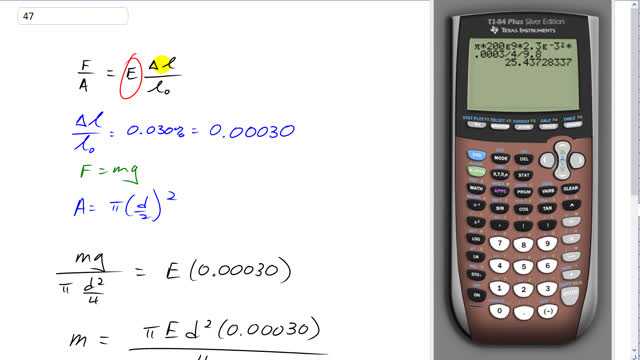
A steel wire 2.3 mm in diameter stretches by 0.030% when a mass is suspended from it. How large is the mass?

In order to watch this solution you need to have a subscription.
This is Giancoli Answers with Mr. Dychko. For stretching or compression, the force applied divided by the cross-sectional area of whatever's being stretched or compressed equals its elastic modulus times the change in length divided by the original length. So we are told that the steel wire has a 0.03 percent change in length so that means Δl over l is 0.030 percent which we convert to a decimal as 0.00030— percent divided by 100— that's what 'per cent' means by the way, 'cent' is 'sɛnt' in French and it means a 100 and if you have a number per 'sɛnt', it means per 100. So 0.030 percent works out to this divided by 100 that makes this number— just for your curiosity. And we have F is mg—the weight of the thing that's hanging— and area is π times its radius squared— diameter of 2 squared— and then we substitute all this into our equation here and here's the result of the substitution. So we have mg in place of F, area's replaced by πd squared over 4 and that equals elastic modulus times the fractional change in length which is 0.00030. And multiply both sides by one quarter so this 4 cancels with this 4, multiply the other side by 1 quarter and you end up with 4 on the bottom and the rest of it should make sense anyway. So there's a π and a d squared on the top here because we multiplied both sides by πd squared so that it cancels on the left. And then also dividing both sides by g and so we have πE times d squared times the fractional change in length over 4 times gravitational field strength. So that's π times 200 times 10 to the 9 newtons per square meter is the elastic modulus for steel times 2.3 times 10 to the minus 3 meters—diameter—squared times 0.00030 divided by 4 and then times 9.8 newtons per kilogram and that gives about 25 kilograms must be the mass that's hanging.